Work samples
-
Innocent Ignorance
Innocent Ignorance, a documentary short film, tells the story of oyster shell recycling and reef building, paralleling both Southeastern Louisiana and the Chesapeake Bay region as well as the experience of older and younger generations with environmentalism. This was my first documentary film and I learned a lot from the process.
-
 Human Indifference
Human IndifferenceThis image encapsulates in a more creative and fabricated way humans’ impacts on the environment-we have created a world that is incredibly polluted, threatened, and destroyed, and yet seem to be okay with not taking tangible action to prevent further destruction and dismantle the systems that perpetuate it (often even continuing to do even more harm). It is more than just innocent or blissful ignorance on the part of those in power.
To clarify, however, this does not target to the many subjected to environmental injustice every day, rather those in the position to make change who choose to continue the cycle to prioritize profit and exploitation. There was an image of a mountain landscape taped to the floor in the gallery in front of the wall with the rest of the images; the piece on the floor that you have been forced to walk on to engage with the rest attempts to emphasize that reality-a lot of blame is placed on individuals as a way of shifting blame from corporations for these issues, but we are all forced to participate in these systems in ways big and small, whether we want to or not.
-
Bridging the Gap Preview
This video gives a preview of a documentary short film I directed about a small non-profit working in the mountains of Greece. Bridging the Gap, done in partnership with nonprofit Ecogenia, tells the story of how Ecogenia's trail building work can help address problems concerning youth unemployment and depopulation of rural villages in Greece through a civic service framework.
-
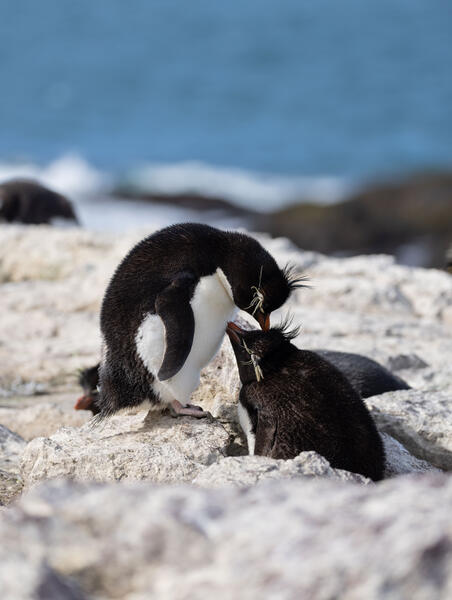 Rockhopper Penguins: Mates for Life
Rockhopper Penguins: Mates for LifeThis image is part of a series that asked questions about conservation and nature photography and its benefits and harms to environmental activism and the environment itself. In this image of penguins for example, the beauty and the connective nature of penguins as a flagship species and their unwavering love is displayed, but hiding outside of the frame is a harsh reality that anthropogenic changes are cascading into negative effects for these sub-polar penguins and their reproductive cycles.
About Katy

Hi! I am interested in the intersection between environmentalism and art, specifically the ways in which digital media, like photography and documentary filmmaking, can be used to communicate environmental issues and encourage environmental conservation in an intersectional manner. I have a Bachelor of Arts in Filmmaking, Photography, and Environmental Studies and a Bachelor of Science in Environmental Biology from Tulane University and just finished a Master of Science in Ecology with a… more
Innocent Ignorance
Innocent Ignorance tells the story of oyster shell recycling and reef building, paralleling both Southeastern Louisiana and the Chesapeake Bay region as well as the experience of older and younger generations with environmentalism. The project started as capstone for my filmmaking degree but grew into a project that encompassed not only the area I had grown to love as my second home but the one I grew up in as well.
I was jack of all trades for this film - the director, editor, director of photography, sound mixer, colorist. It was also my first time making a documentary short film, through which I learned a lot about both the technical skills and the storytelling expertise that goes into producing a film from scratch (and continued to learn with my second project).
-
Innocent Ignorance
Innocent Ignorance, a documentary short film, tells the story of oyster shell recycling and reef building, paralleling both Southeastern Louisiana and the Chesapeake Bay region as well as the experience of older and younger generations with environmentalism. This was my first documentary film and I learned a lot from the process.
Bridging the Gap
Bridging the Gap, done in partnership with nonprofit Ecogenia, tells the story of how Ecogenia's trail building work can help address problems concerning youth unemployment and depopulation of rural villages in Greece through a civic service and climate sensitive framework. I got the chance to travel with a bunch of other filmmakers to learn about Ecogenia's work and complete a series of films (this film is one of seven created on the trip) showcasing their journey and they've been working to save that they could use for outreach and fundraising, which has allowed them to expand their work into a second area this coming summer.
I was the director of this film and one of the editors. I continued to learn from my first experience with Innocent Ignorance about building a story while staying true to reality, both technically and in a storytelling capacity. I also got a chance to expand on that knowledge as I had a small team this time, so I got a chance to experience more collaboration and management in this second project to produce a film we were all proud of and that truly supported our partner organization, Ecogenia.
Environmental Photography: Deconstructions
This project was part of a gallery exhibition I put together as part of group show in 2023. It pulls from my experiences as an environmentalist and a photographer and asks questions about conservation photography and environmental attitudes as a whole.
All of these images attempt to create conversations focused on environmental issues in one way or another. There are many different tactics used in environmental communication and environmental storytelling that attempt to incite discussion and activism, all of which have their advantages and disadvantages. This collection is not only one of powerful images but also of different attempts at effective environmental storytelling through film and photography, which are explained more in the following descriptions.
I encourage you to follow from Part 1 in numerical order (parts with multiple images follow as Part 2A, Part 2B, etc), which simulates in a virtual setting how the eye would have tracked and how the rest of the description moved along the gallery space through the series.
Part 1 accompanying text:
This image encapsulates in a more creative and fabricated way humans’ impacts on the environment-we have created a world that is incredibly polluted, threatened, and destroyed, and yet seem to be okay with not taking tangible action to prevent further destruction and dismantle the systems that perpetuate it (often even continuing to do even more harm). It is more than just innocent or blissful ignorance on the part of those in power.
To clarify, however, this does not target to the many subjected to environmental injustice every day, rather those in the position to make change who choose to continue the cycle to prioritize profit and exploitation. There was an image of a mountain landscape taped to the floor in the gallery in front of the wall with the rest of the images; the piece on the floor that you have been forced to walk on to engage with the rest attempts to emphasize that reality-a lot of blame is placed on individuals as a way of shifting blame from corporations for these issues, but we are all forced to participate in these systems in ways big and small, whether we want to or not.
Part 2 accompanying text:
The three images of penguins directly above are part of a series of images about the Magellanic (Spheniscus magellanicus) and Southern Rockhopper (Eudyptes chrysocome) penguins taken while in the Patagonia region in Argentina.These images aspire to create a connection to these penguins and the issues they face from adverse effects of anthropogenic climate change by focusing on aesthetics.
By attempting to remove the human aspect (in contrast to the diptych series in Part 4) and focusing on capturing the natural existence and behaviors of these penguins, this series attempted not to anthropomorphize them but rather to give them space outside of human influence in the frame as a way of leveraging them as worthy of protection and valoration outside of any connection to human advantages.
But is that possible given the collective outlook humans have on the rest of the natural world around them? Is it possible to bring attention to their issues without being exploitative of their image? These are all questions this series also asks about not only these but all nature photography type images.
Beyond being species deserving of protection in their own right, penguins act as both flagship species and bioindicators-indicators of the health of an ecosystem, in this case the ocean, which is highly threatened by anthropogenic climate change but also often under acknowledged. I was able to be a part of some on-going research on the Magellanic penguins which indicates that there have been and will continue to be serious changes in their reproductive cycle in the future, which is of serious concern.
I encourage you to consider your reaction to these images: was it something more along the lines of “they’re so cute”? Was it more of concern? Through what lens did you view them? Where did you think of yourself in relation to them in terms of superiority?
Part 3 accompanying text:
Take a look at the image in Part 3. What do you see? Do you notice the spray and beauty of the existence-even simply in their breath-of these creatures? Now what if I told you that spray is full of microplastics, the number of which are growing by the day in ocean ecosystems and therefore within the blood and breath of every marine organism. I encourage you to consider the way you view the natural world around you and the problems its appearance of being unaffected can hide.
Part 4 accompanying text:
The three pairings of images, called diptychs, in Part 4 explore the human-environment relationship. Both images in each pair were taken on the same day at the same location. In contrast to the larger penguin images, it also explores the way that the camera often does not tell the whole story, especially in cases of ecotourism. This section focuses on the relationship between the places and organisms supposedly relatively untouched by direct human impact-which are the subject of many ecotourism endeavors-and the direct human impact and presence such ecotourism produces.
Additionally, it highlights the manner in which in many examples of environmental photography, the subject-be that a landscape or a specific species-is often separated from the other anthropogenic circumstances that exist around it. At the same time, however, the images produced in such circumstances can hold immense value in conservation communication and inspiring action.
Part 5 accompanying text:
And finally, Part 5 encourages you to continue engaging with the human-environment relationship and environmental issues and reflect on any and everything that these pieces may have brought up. I encourage you to voice your hopes that we can turn it around, your frustrations that we have not yet done it, the joy that the natural world brings you, the sadness, and anything in between. In the gallery space, a sharpie was provided to write on the image and create a collective piece - I encourage you to do the same here with the comment feature!
-
 Human Indifference
Human IndifferenceThis image encapsulates in a more creative and fabricated way humans’ impacts on the environment-we have created a world that is incredibly polluted, threatened, and destroyed, and yet seem to be okay with not taking tangible action to prevent further destruction and dismantle the systems that perpetuate it (often even continuing to do even more harm). It is more than just innocent or blissful ignorance on the part of those in power.
To clarify, however, this does not target to the many subjected to environmental injustice every day, rather those in the position to make change who choose to continue the cycle to prioritize profit and exploitation. There was an image of a mountain landscape taped to the floor in the gallery in front of the wall with the rest of the images; the piece on the floor that you have been forced to walk on to engage with the rest attempts to emphasize that reality-a lot of blame is placed on individuals as a way of shifting blame from corporations for these issues, but we are all forced to participate in these systems in ways big and small, whether we want to or not.
-
 Part 2A: Magellanic Penguin
Part 2A: Magellanic PenguinThe three images of penguins in Part 2 are part of a series of images about the Magellanic (Spheniscus magellanicus) and Southern Rockhopper (Eudyptes chrysocome) penguins taken while in the Patagonia region in Argentina.These images aspire to create a connection to these penguins and the issues they face from adverse effects of anthropogenic climate change by focusing on aesthetics.
By attempting to remove the human aspect (in contrast to the diptych series in Part 4) and focusing on capturing the natural existence and behaviors of these penguins, this series attempted not to anthropomorphize them but rather to give them space outside of human influence in the frame as a way of leveraging them as worthy of protection and valoration outside of any connection to human advantages.
But is that possible given the collective outlook humans have on the rest of the natural world around them? Is it possible to bring attention to their issues without being exploitative of their image? These are all questions this series also asks about not only these but all nature photography type images.
-
 Rockhopper Penguins: Mates for Life
Rockhopper Penguins: Mates for LifeThis image is part of a series that asked questions about conservation and nature photography and its benefits and harms to environmental activism and the environment itself. In this image of penguins for example, the beauty and the connective nature of penguins as a flagship species and their unwavering love is displayed, but hiding outside of the frame is a harsh reality that anthropogenic changes are cascading into negative effects for these sub-polar penguins and their reproductive cycles.
-
 Part 2C: Magellanic Penguin
Part 2C: Magellanic PenguinI encourage you to consider your reaction to these images: was it something more along the lines of “they’re so cute”? Was it more of concern? Through what lens did you view them? Where did you think of yourself in relation to them in terms of superiority?
-
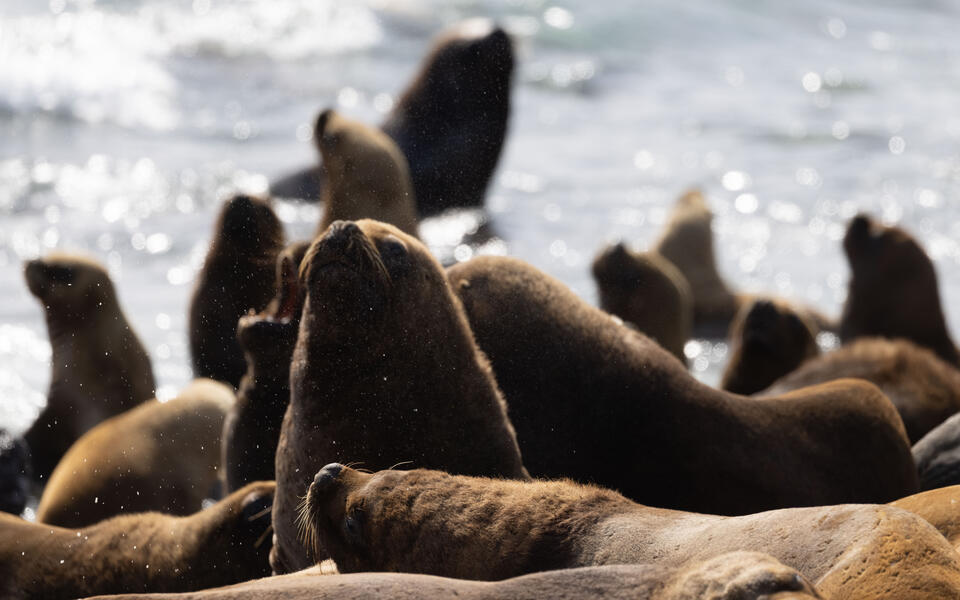 Part 3: Seal Spray
Part 3: Seal SprayTake a look at the image. What do you see? Do you notice the spray and beauty of the existence-even simply in their breath-of these creatures? Now what if I told you that spray is full of microplastics, the number of which are growing by the day in ocean ecosystems and therefore within the blood and breath of every marine organism. I encourage you to consider the way you view the natural world around you and the problems its appearance of being unaffected can hide.
-
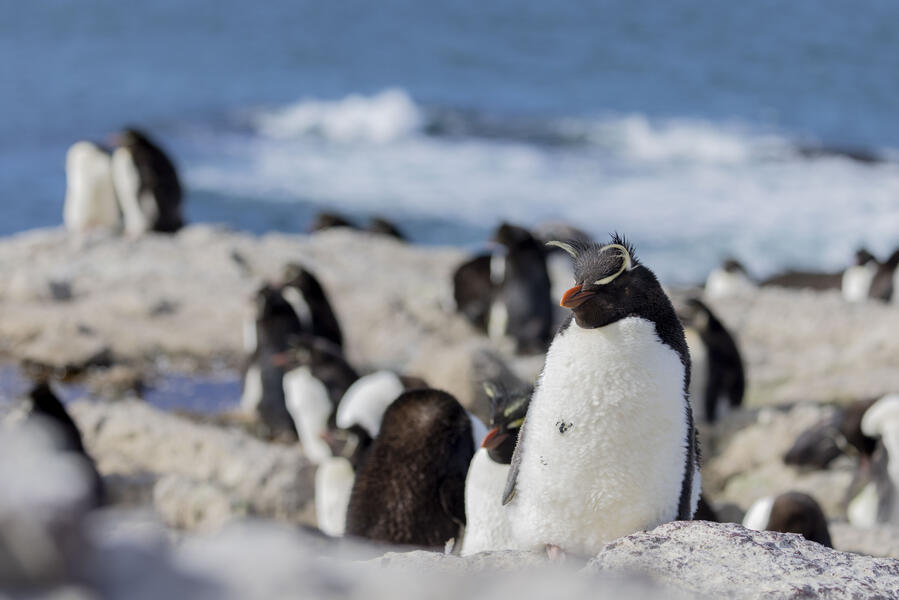 Part 4: Diptych Pairing 1 (A)
Part 4: Diptych Pairing 1 (A)This is image A of Pairing 1.
The three pairings of images, called diptychs, in Part 4 explore the human-environment relationship. Both images in each pair were taken on the same day at the same location. In contrast to the larger penguin images, it also explores the way that the camera often does not tell the whole story, especially in cases of ecotourism. This section focuses on the relationship between the places and organisms supposedly relatively untouched by direct human impact-which are the subject of many ecotourism endeavors-and the direct human impact and presence such ecotourism produces.
-
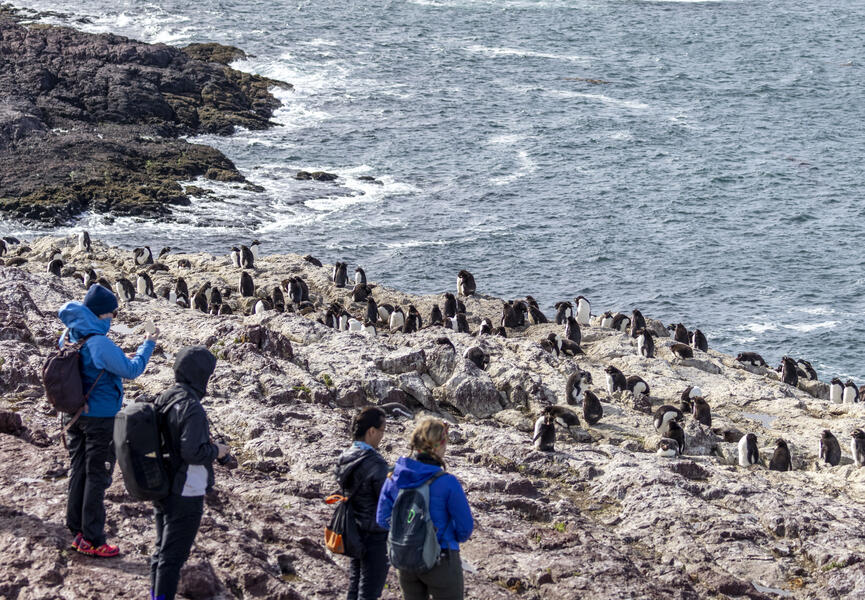 Part 4: Diptych Pairing 1 (B)
Part 4: Diptych Pairing 1 (B)This is image B from Pairing 1.
Additionally, these diptychs highlights the manner in which in many examples of environmental photography, the subject-be that a landscape or a specific species-is often separated from the other anthropogenic circumstances that exist around it. At the same time, however, the images produced in such circumstances can hold immense value in conservation communication and inspiring action.
-
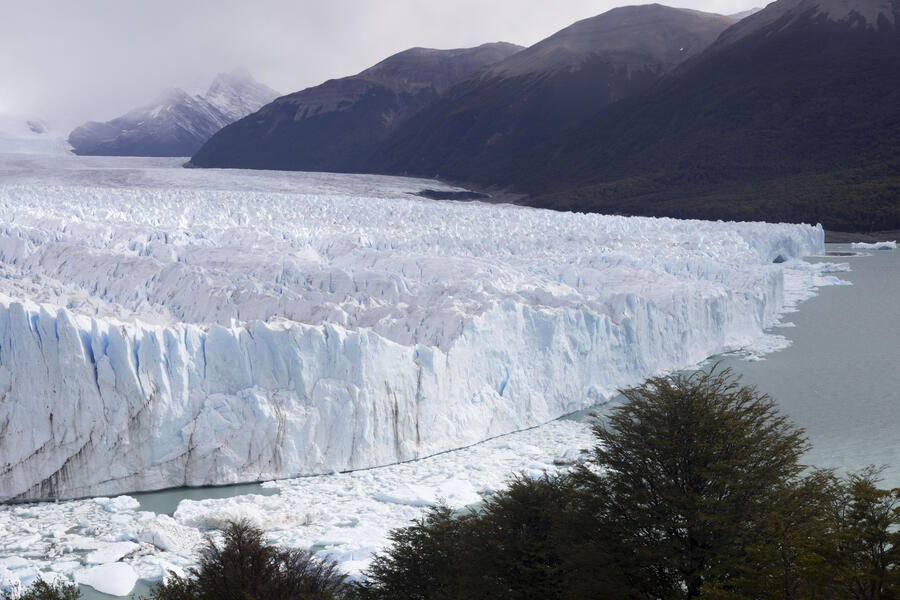 Part 4: Diptych Pairing 2 (A)
Part 4: Diptych Pairing 2 (A)This is image A of Pairing 2.
It is of the Perito Moreno Glaciar in Argentina, and demonstrates how even the most seemingly untouched landscapes are influenced by human interaction, but also how small humans are relative to many natural formations and how strong environmental systems can be.
-
 Part 4: Diptych Pairing 2 (B)
Part 4: Diptych Pairing 2 (B)This is image B in Pairing 2.
It shows the humans hiking on the same glacier pictured in the other part of the diptych. It highlights how ecotourism touches all areas of the globe, bringing up questions about ecotourism in general, the benefits from a conservation attitudes standpoint, and the harms when not done responsibly.
-
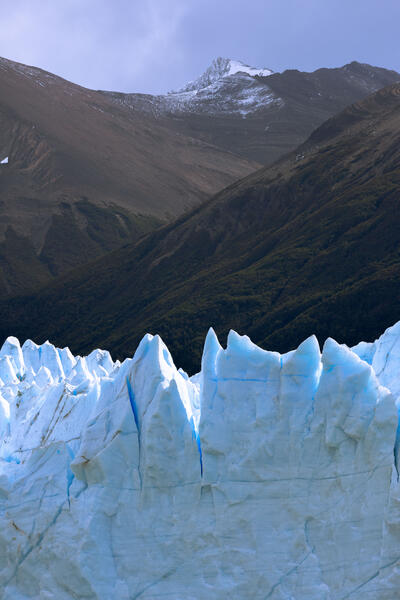 Part 5: Reflections
Part 5: ReflectionsAnd finally, Part 5 encourages you to continue engaging with the human-environment relationship and environmental issues and reflect on any and everything that these pieces may have brought up. I encourage you to voice your hopes that we can turn it around, your frustrations that we have not yet done it, the joy that the natural world brings you, the sadness, and anything in between. In the gallery space, a sharpie was provided to write on the image and create a collective piece - I encourage you to do the same here with the comment feature!
ReCoast: The Possibilities of Recycled Glass Sand
This series of images serves as a way of sharing the field work done as part of an environmental research project investigating the potential for recycled glass sand to be used in coastal restoration on beaches by testing the growth of beach plants in that recycled glass sand.
In these examples, researchers are pulling up their field experiment so they can analyze the plants and determine the effect of the glass sand on the plants’ growth (or lack thereof). You can see science in action in these images: the researchers had previously filled pots with three different sand treatments - the glass sand, normal beach sand, and glass sand with bacteria found in natural beach sand - and left the plants to grow. They are now digging those plants up, removing the sand, and measuring the biomass (weight of the leaves and roots) of the plants to analyze the plants’ growth. Organisms like the Gulf Fritillary (orange butterfly) depend on these plants, as can be seen in one of the images, and therefore not only is it important to understand the effect of using glass sand for the plants themselves but also for all of the insects and other organisms that depend on it.
If the project shows that glass sand does not affect plant growth in a negative way, this could have major impacts for coastal restoration on beaches, protection of coastal communities, and repurposing of glass that would otherwise end up in a landfill for ecological benefit rather than harm.
-
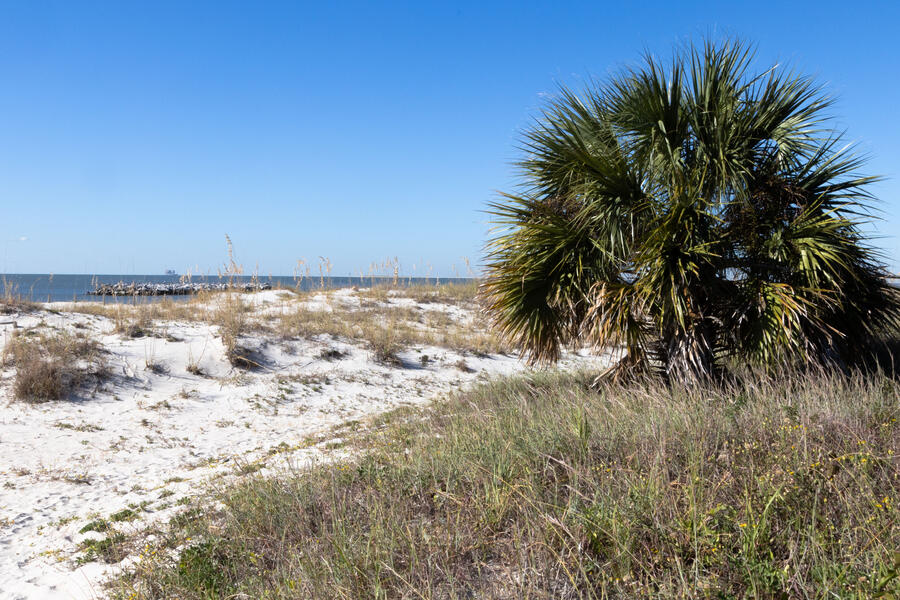 ReCoast Project: The Setting
ReCoast Project: The SettingThis image shows the beach where the research project took place in Dauphin Island, Alabama.
-
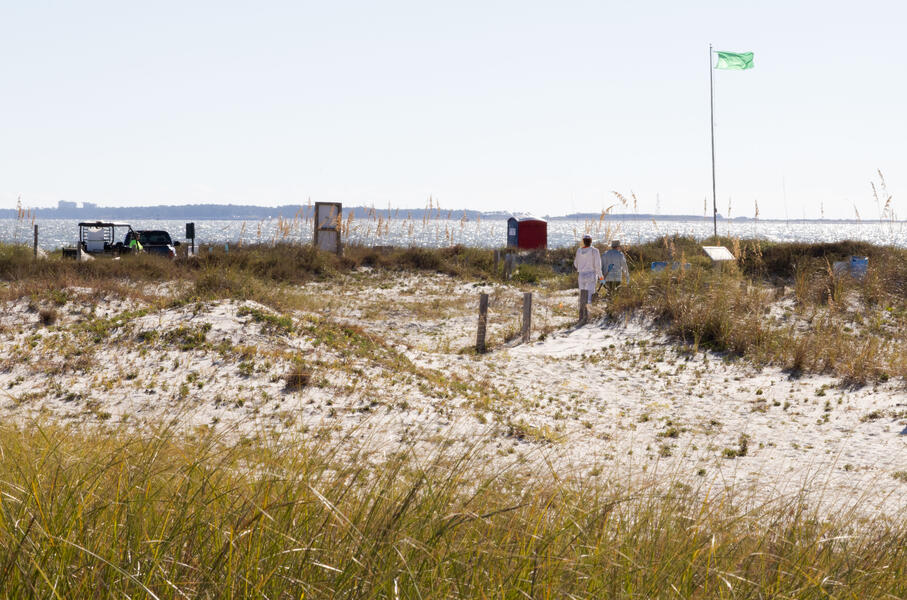 ReCoast Project: The Researchers
ReCoast Project: The ResearchersThis image shows the field site the researchers chose to place the plants in at the beginning of the experiment.
-
 ReCoast Project: The Principal Investigators
ReCoast Project: The Principal InvestigatorsIn this image, you can see the flag sticking up as the researchers return to the places where they potted the plants - each different colored flag represented a different condition in the experiment.
-
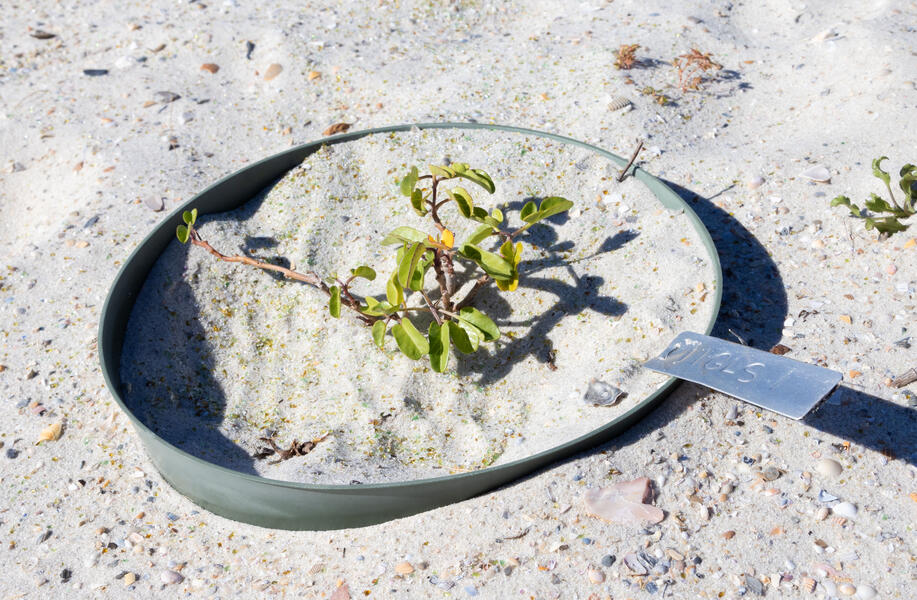 ReCoast Project: The Plants
ReCoast Project: The PlantsThe researchers placed potted plants in the beach plot months before with different conditions (regular sand, glass sand, glass sand with bacteria that would be found in normal sand). Those conditions were marked on metal tags, seen here, and the pots were placed in the beach environment for this field experiment.
-
 ReCoast Project: Removing the Plants
ReCoast Project: Removing the PlantsOnce located, the plants were dug up in their pots so their biomass could be measured.
-
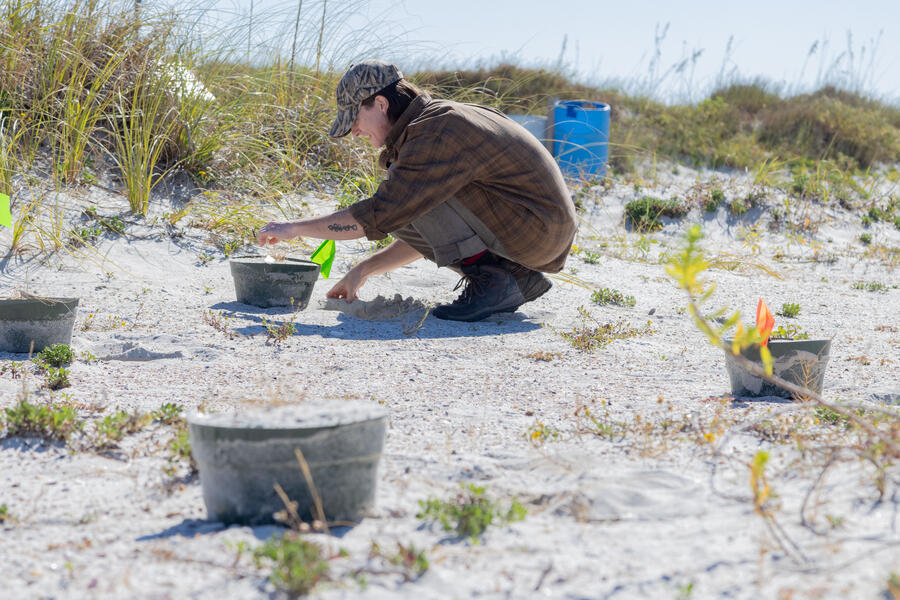 ReCoast Project: Removing Extra Roots
ReCoast Project: Removing Extra RootsResearchers were careful to pull up not only the pots but also any extra roots left behind in the soil to accurately measure the biomass of each plant.
-
 ReCoast Project: Sifting
ReCoast Project: SiftingAfter removing the pots and any roots left behind from the beach plot, the pots were sifted twice to remove sand, leaving behind the plant biomass which could be measured.
-
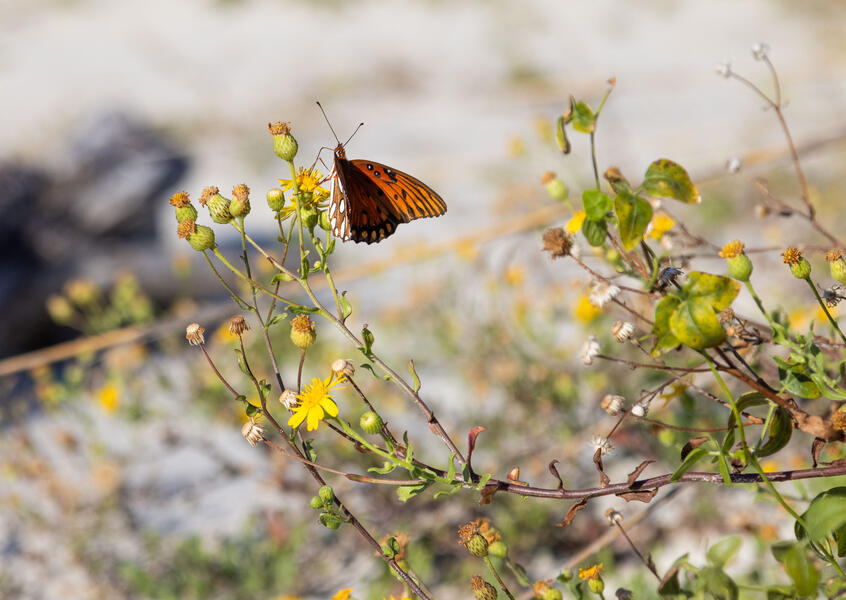 ReCoast Project: Gulf Fritillary
ReCoast Project: Gulf FritillaryNot only is this experiment important for understanding the plants themselves, but also for the ecosystem as a whole and the other organisms that depend on these plants, like the Gulf Fritillary butterfly pictured here.
-
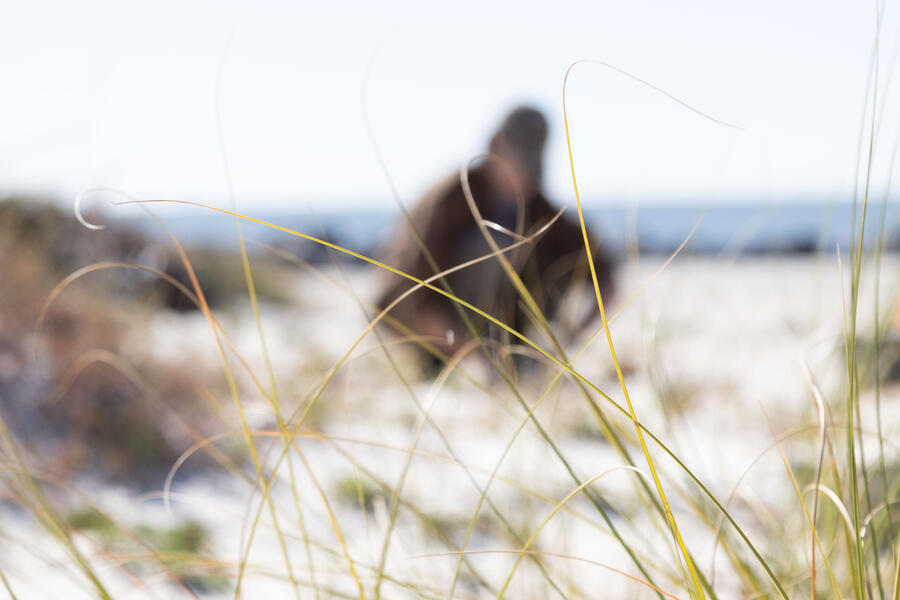 ReCoast Project: The Impact
ReCoast Project: The ImpactThis project has a myriad of potential impacts, just as the placing of recycled glass sand has a lot of potential impacts for the ecosystem were it to be used in coastal restoration. That is why this research is so important: we need to understand the potential consequences of our actions before using this as a conservation solution, but if the ecosystem impacts are neutral or even positive, this could prove to be a valuable solution to both recycling and coastal erosion issues.



















